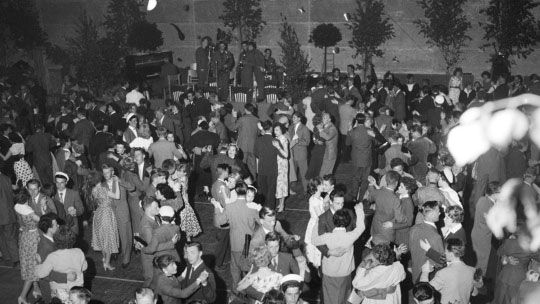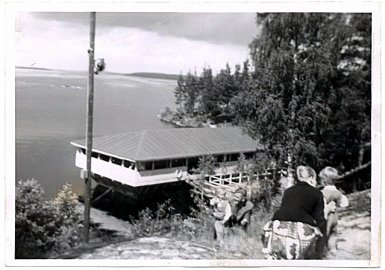
If you are a Finn involved in Argentine tango, you’d better be used to questions about differences between Argentine and Finnish tango. Or maybe you’re a visitor familiar with Argentine tango and having heard that there’s a peculiar species of tango also in Finland. Either way, I hope this post will give you some idea how two nations in the hot south and in the cool north developed dance and music styles that served their emotional and social needs.
As you might guess, my involvement with tango began with the Finnish one. I wasn’t much of a dancer, but as music was my stuff, I wanted to explore the wistful atmosphere of Finnish tango through pen and music paper. Having composed a few Finnish tangos (under a pseudonym) I felt a need to go further and check out the very origins of tango. When Spotify opened the cornucopia of Argentine tango before my ears, there was no return.
Today, as I have learned more and more about the history of tango, it seems quite obvious that the main source of differences is the fact that Argentine tango is an urban phenomenon whereas its Finnish counterpart is a rural one. We’ll return to that point later in this post, but let’s see first how tango came to Finland and how it established its position.
The decades of tango in Finland
Born in the unpaved and unlit streets of the outskirts of Buenos Aires, tango was a wild sensation when introduced in Europe. First tango performances were seen in Paris around 1910, but World War soon hampered inter-Atlantic connections. After the war, however, tango took Europe by storm. By the 1930’s tango was one of the most fashionable dances in Europe along with fox trot.
European song makers soon began writing their own tangos. Their idea of tango was based on the idioms they absorbed during the period around World War. Thus, the development Argentine tango went through during the 1920’s was not reflected in European tango. The most distinctive feature resulting from this is the habanera rhythm that practically disappeared from Argentine tango during the 1920’s but was retained in Europe. As a social dance, European dance teachers wanted to standardize tango steps, and so ballroom tango was born.
In Finland the very first performance was seen in 1913. Tango aroused some interest but did not gain much popularity – as a fad it had to compete with fox trot, and it lost. Besides, the majority of Finnish population lived in the countryside where traditional dances such as waltz, polka and schottische (jenkka) reigned. People who wanted to dance tango tried to imitate the steps they saw at tango shows, and the dance style originating from this is known as Old Finnish Tango, which has received growing interest and attempts of revival during the recent years. Some trendy townspeople also took classes in ballroom tango.
Things changed in the 1930’s when a Finnish dance teacher developed a kind of simplified tango based on fox trot steps. As in fox trot, the basic step pattern slow-slow-quick-quick is repeated all over the dance, and no side steps are taken. Contrasting fox trot, there is no bounce in the steps thus making a smooth movement with slightly bent knees. Feet are interleaved, not to-to-toe like in Argentine tango, and the embrace has a low contact point at the pelvis.
Due to the wider acceptance as a social dance, Finnish tango music also emerged. The first recordings to be considered as dance music were made in mid-30’s, and during World War II tango was the music genre to provide an escape from the harsh reality, but it wasn’t until after the war when the popularity of tango really exploded. Why this happened is to be found in the post-war society.
The social function of tango
The main function of tango has always been to seek contact with the opposite sex. In Buenos Aires the main challenge was that the sexes were not in proportion. Single men were pouring in as immigrants, and women were something to compete for. Were this done with knives or guns, the society would have fallen into pieces. Lucky for us and them, a cultural skill was chosen as a means to compete. Proficiency in tango also served as way for hard-working men to gain appreciation among their peers.
Given this it is no surprise that there is a lot of machismo in Argentine tango. In the original context of tango, a man has to conquer the woman, and he does this by displaying his virility through his tango skills. The woman, however, is not just a passive object. She uses adornments to tease the man and to show her interest whenever she chooses.
In Finland after WW II the situation was quite opposite. During the war 10 percent of male population had lost their lives or were permanently injured, so there was a lack of men, not women. In addition, hundreds of thousands of young men had spent their best years at the front, many of them emotionally hurt by the horrors of war. Now they had to join the peace-time society and raise a family. Almost half a million people from Karelia, most of them farmers, had lost their homes, and more than a hundred thousand new family farms had to be formed and cultivated. You cannot build a family farm if you haven’t got a family, and this is where tango came to help.
During the post-war period every village had at least one community house plus a summer dance pavilion, typically by a lake. These were the very nests of Finnish tango. For a midsummer feast, tango was as essential as the traditional bonfire, and the luminous nights of June were reflected by birth rates in March.

One could say that Finnish tango is not about conquering a woman but finding a mutual partnership. How did tango help in this task? We have gathered a bunch of ingredients for the Finnish encounter with tango: a dance pavilion with a lake view, a shy young man, a simple dance that does not require highly developed skills or a macho attitude, a mood full of longing, and a girl that also wants to find a partner for her life. What is missing, what is the thing that should weld the hearts of these two people together in a shared experience? It’s music, of course!
So what about the music?
The development of Argentine tango during the 1930’s and 40’s emphasized the need to include different musical characters or moods in one piece in order to let the dancers demonstrate their skills, grace and imagination. Finnish tango, however, didn’t have to fulfill this need, and each piece is thus in one mood only, just like the vast majority of popular music in the world.
Practically all Finnish tangos are songs, most of them highly melodic, and popular songs seldom contain contrasting segments the way Golden Era Argentine tangos do. This also means that there is little incentive to vary your dancing during a piece, which parallels the idea of simplified step patterns. So is a Finnish tango just three minutes of dull or primitive walking void of any rhythmic experience? Not at all, and that’s due to a clever system that produces rhythmic variation like a kaleidoscope.
As we learned earlier, European tango retained the habanera rhythm, and this also more or less applies to the majority of Finnish tangos. In addition to that, there is another rhythmic feature that is unique to Finnish tango: a backbeat at the end of a measure. This means that the last weak beat in a bar is accented, a 1/16 note in 2/4 or 4/8 time or a 1/8 note in 4/4 time – not in every measure but every now and then, often irregularly. These rhythmic levels, absent from Argentine tango, produce ever-changing rhythms when combined with the slow-slow-quick-quick step pattern.

It is a funny thing to note that this idea of layered rhythms is the propelling power of Afro-Latin music. When we add the fact that also beguine rhythms are often heard in Finnish tangos, it seems that Finnish tango musicians have kind of reinvented Latin music in a way that suits the Finnish temper. Adding a beautiful melody and longing lyrics, the dancing couple will be able to feel they are carried away into another world where the worries of tomorrow will fade into oblivion, like the words of a well-known Finnish tango put it.
Listen to it!
To get an idea of the style features of Finnish tango, it might be a good idea to listen to an Argentine tango arranged and performed in Finnish style. I have chosen no less than the most famous tango in the world, La Cumparsita, with an Argentine performance for comparison:
La Cumparsita, Olavi Virta & Metro-Tytöt 1953
La Cumparsita, Juan D’Arienzo 1951
My absolute favorite among Finnish tango composers is Toivo Kärki, the master par excellence of post-war popular music in Finland. An infallible sense of harmony and melodic curve is his trademark, and although his compositions in other genres prove that he could master any mood, all his tangos reflect the wistfulness repeatedly mentioned in this post. As an example of his work I have chosen here three of his early tangos from 1944 to 1950. Two of these videos are from Finnish music films built around those songs.
Siks’ oon mä suruinen
Laulava sydän
Köyhä laulaja
After the era of Toivo Kärki, one of the most beloved Finnish tangos has been Soi maininki hiljainen by Fridrich Bruk. Interestingly, the composer was born in Ukraine and received his training in Russia, but spent most of his professional career in Finland. It’s quite a slow tango with a distinctive habanera rhythm. No decent version is available on YouTube, but I hope you have got Spotify. Please enjoy!